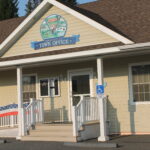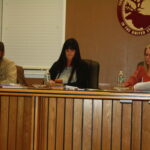Aroostook Skies: Childhood’s end
By Larry Berz
In 1967, “City on the Edge of Forever” appeared on the original “Star Trek” series. It unforgettably depicted a fascinating, compelling science fiction adventure/romance in which Starship Captain Kirk and First Science Officer Spock hurtle through a strange, ring-like time portal, called “The Guardian”. Their mission: to recover and save an accidentally drug-crazed Dr. McCoy, the ship’s medical officer who, without authorization, beamed down to the planet’s surface.
Channeling and tunneling back to old New York City during the depths of the Great Depression (circa 1930), the starmen spar with society, ultimately rescued and nurtured by the lovely, idealistic Edith Keiler, the coordinator of a local mission/shelter for the urban homeless. Well, you guessed it. Kirk falls hopelessly in love with Christian Keiler while Spock, bereft of the benefit of specialized supplies, slowly uncovers the glitch in time caused by the unplanned excursion of McCoy through “the Guardian”.
In a startling admission, Jim Kirk confesses to his Vulcan companion “I think I’m falling in love with Edith Keiler.” Spock replies sternly and slowly, not missing a beat: “Edith Keiler must die.” Why?
Evidently McCoy’s inadvertent penetration into Earth’s history set in motion a chain of events whereby this gifted young woman would carry her passion for peace and good will to Washington D.C. and delay America’s entry into World War II. The Nazi regime under Adolph Hitler’s pathological tyranny could thus first complete its nuclear research program, and atomically destroy all allied enemies to ensure German victory and world dominance.
Fortunately (for the viewer as well as Earth), the officers discover a sobered McCoy (ironically housed in the same NYC shelter). In spite of Edith Keiler’s tragic death by automobile and Captain Kirk’s broken heart, time returns restored and the USS Enterprise proceeds boldly forward to complete its entertaining and visionary exercise in commercial American television for the next two years, seeking new markets and new syndication, to bravely sell where no prime time television had gone before!
Watching that program with the eyes and ears of a healthy, privileged suburbanite in urban Chicago, I never forgot the themes of sacrifice, love, adventure, humor, and duty, which this program dramatized. As much as modern times corrode my sense of childhood values, ideals, and virtue, I never surrendered my personal passion. The dramatization reinforced the embryonic compassion a boy senses at that age (at least this boy). I had, thankfully, time to permit these attitudes to incubate within my little soul and innocence enough to permit them to influence my adult Universe after childhood’s end.
Children today, however, live in difficult times. Pressures impose themselves upon them, propelling our best and brightest toward prematurity in adult environments and themes. As America seeks a new global equilibrium, the market place seduces our children to participate in its mad money-making schemes by introducing new forms of graphic gaming and completely inappropriate super sensory stimulation. Electronic, digitized appliances titillate our progeny, diverting a new generation from relational virtues and substituting instead an impotent emotion-crazed affect that obscures reality.
Cosmic popularizer Carl Sagan creatively describes the cultural landscape: “An extraterrestrial being, newly arrived on Earth — scrutinizing what we mainly present to our children in television, radio, movies, newspapers, magazines, the comics, and many books — might easily conclude that we are intent on teaching them murder, rape, cruelty, superstition, credulity and consumerism. We keep at it, and through constant repetition many of them finally get it.”
In 1967, the Reverend Dr. Martin Luther King, Jr. addressed a partisan audience with poignant question: “Where do we go from here?” His concerns at the time pointed to a quest for economic action and an agenda in promoting the equality of Afro-America. Today, the issue mushrooms and surrounds a cultural battle for the minds and hearts of our children. For surely, in due time, childhood will end, always end.
If as astronomy educator Timothy Ferris points out “all dreams begin in childhood,” how can we ensure the survival and purity of those dreams into an adult consciousness? Furthermore, our success in correctly modeling the themes of our times will either emancipate and empower or enshackle and enslave our kids to the future, a future where, as Sagan forecasts, “the United States is a service and information economy; when nearly all the key manufacturing industries have slipped away to other countries; when awesome technological powers are in the hands of the very few, and no one representing the public interest can even grasp the issues; when the people have lost the ability to set their own agendas or knowledgeably question those in authority; when, clutching our crystals and nervously consulting our horoscopes, our critical faculties in decline, unable to distinguish between what feels good and what’s true, we slide, almost without noticing, back in to superstition and darkness.”
What must we do if really do inhabit a society where, as Dr. King once said 46 years ago, we face the choice of “mutual cooperation or violent co-annihilation”? Science may hold one of the keys, the key of hope.
I believe science offers, at its God-given best, four essential ingredients for public, grass-roots empowerment. Again, the voice of Carl Sagan. Science still offers an avenue out of personal poverty and backwardness. Proper scientific education leads to strong minds capable of questioning and seeking answers with a refreshed insight into Nature and natural processes. Secondly, science offers a “early warning system” to alert communities to technological forces which may imperil our safety and security. Thirdly, science offers a unique awakening and adventure to understanding “our cosmic context, about where, when and who we are.” Finally, science reinforces and strengthens the best of our democratic instincts, scrutinizing with reason and coherence all ideas and opinions in vigorous debate without giving quarter to special vantage points.
Astronomical awareness remains my current purpose and passion. Many of you already participate in my mission at Francis Malcolm Institute, the Maine School of Science and Mathematics, and on the road with the “Goliath” telescope for public sky awareness. May I continue in strength to fortify our minds and infuse and inspire great local goals for our children. May the inevitability of childhood’s end offer faithful direction for the Crown of Maine. The way is narrow, but the destination promising. To dramatize my own commitments, I am announcing to the public a proposed 50-mile walking hike from Houlton to Limestone later in the summer. Stay tuned!
Larry Berz of Caribou is director of Easton’s Francis Malcolm Planetarium and astronomy instructor at the Maine School of Science and Mathematics. The public is urged to attend an Open House at the Science Center on Saturday, May 18 from noon till 3 p.m. For further details, call 488-5451.






